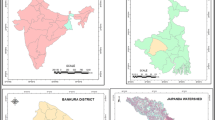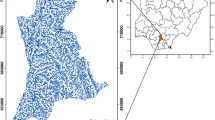Abstract
Soil loss is a serious environmental threat in humid sub-tropical State Tripura. The present study is carried out in Gumti River Basin of Tripura State, North East India having an area of 2492 km2. Long term daily rainfall intensity is very high in this region and that’s why sheet erosion of soil is common phenomena. Spatial distribution of soil loss in the study area was estimated by integrating five essential parameters of universal soil loss equation model in GIS mapping platform (mainly ArcGIS 10.1). Those five parameter are runoff–rainfall erosivity factor (R), soil erodibility factor (K), slope length and steepness (LS), cropping management factor (C), and support practice factor (P). In these study ASTER digital elevation model having 30 m resolution and LISS III image have been used for estimation of LS factor and C factor. The daily rainfall data (2001–2010) of seven rain gauge stations located in the Gumti River Basin and its adjoining area have been used to predict the R factor. Predicted average annual soil loss of the basin has been classified into five categories according to intensity level of soil loss. The high rate (>45 t ha−1 year−1) of soil erosion was found along the main course of Gumti River, interhill valley portion and also the flood plain area of the basin, whereas low amount of soil loss (<10 t ha−1 year−1) was found at densely forested areas and intensely plantation area of the basin.







Similar content being viewed by others
References
Bera A, Namasudra P (2016) Impact of shifting cultivation on the environmental changes in Gumti River Basin, Tripura. Int J Recent Sci Res 7(6):11771–11774
Evans R (1980). Mechanics of water erosion and their spatial and temporal controls: an empirical viewpoint. In: Soil erosion. Wiley, New York, p 109–128
Fistikoglu O, Harmancioglu NB (2002) Integration of GIS with USLE in assessment of soil erosion. Water Resour Manag 16(6):447–467
Ganasri BP, Ramesh H (2016) Assessment of soil erosion by RUSLE model using remote sensing and GIS—a case study of Nethravathi Basin. Geosci Front 7(6):953–961. doi:10.1016/j.gsf.2015.10.007
Ghosh K, De SK, Bandyopadhyay S, Saha S (2013) Assessment of soil loss of the Dhalai River Basin, Tripura, India using USLE. Int J Geosci 4(1):11–23. doi:10.4236/ijg.2013.41002
Irvem A, Topaloğlu F, Uygur V (2007) Estimating spatial distribution of soil loss over Seyhan River Basin in Turkey. J Hydrol 336(1):30–37
Jain SK, Kumar S, Varghese J (2001) Estimation of soil erosion for a Himalayan Watershed using GIS technique. Water Resour Manag 15(1):41–54
Kim HS (2006) Soil erosion modeling using RUSLE and GIS on the IMHA Watershed, South Korea. Doctoral Dissertation, Colorado State University
Kumar S, Kushwaha SPS (2013) Modelling soil erosion risk based on RUSLE-3D using GIS in a Shivalik Sub-watershed. J Earth Syst Sci 122(2):389–398. doi:10.1007/s12040-013-0276-0
McCool DK, Brown LC, Foster GR, Mutchler CK, Meyer LD (1987) Revised slope steepness factor for the Universal Soil Loss Equation. Trans ASAE 30(5):1387–1396
McCool DK, Foster GR, Mutchler CK, Meyer LD (1989) Revised slope length factor for the Universal Soil Loss Equation. Trans ASAE 32(5):1571–1576
Miller RW, Donahue RL (1990). Soils: an introduction to soils and plant growth, 6th edn. Prentice Hall, Englewood Cliffs
Pandey A, Chowdary VM, Mal BC (2007) Identification of critical erosion prone areas in the small agricultural watershed using USLE, GIS and remote sensing. Water Resour Manag 21(4):729–746. doi:10.1007/s11269-006-9061-z
Rama Rao MSV (1962) Soil conservation in India. Indian Council of Agricultural Research, New Delhi. Retrieved from http://krishikosh.egranth.ac.in/handle/1/2049015. Accessed 2 January 2017
Renard KG, Yoder DC, Lightle DT, Dabney SM (2011) Universal soil loss equation and revised universal soil loss equation. In: Morgan RPC, Nearing MA (eds) Handbook of erosion modeling. Blackwell Publishing Ltd., Oxford, p 137–167
Singh G, Rambabu VV, Chandra S (1981). Soil loss prediction research in India. Bulletin of Central Soil and Water Conservation Research and Training Institute, T12/D9, Dehradun
Toy TJ, Foster GR, Renard KG (2002) Soil erosion: processes, prediction, measurement, and control. Wiley, New York
Tripathi RP, Singh HP (1993) Soil erosion and conservation. New Age International Publishers, New Delhi, p 10
Vinay M, Ramu, Mahalingam B (2015) Quantification of soil erosion by water using GIS and Remote Sensing techniques: a study of Pandavapura Taluk, Mandya District, Karnataka, India. ARPN J Earth Sci 4(2):103–110
Wischmeier WH, Smith DD (1965). Predicting rainfall-erosion losses from cropland east of the Rocky Mountains, guide for selection of practices for soil and water conservation. Agriculture handbooks, US Government Print Office, Washington, DC
Wischmeier WH, Smith DD (1978) Predicting rainfall erosion losses: a guide to conservation planning. Agriculture handbook, vol 537. US Department of Agriculture, US Government Printing Office, Washington, DC
Author information
Authors and Affiliations
Corresponding author
Rights and permissions
About this article
Cite this article
Bera, A. Assessment of soil loss by universal soil loss equation (USLE) model using GIS techniques: a case study of Gumti River Basin, Tripura, India. Model. Earth Syst. Environ. 3, 29 (2017). https://doi.org/10.1007/s40808-017-0289-9
Received:
Accepted:
Published:
DOI: https://doi.org/10.1007/s40808-017-0289-9




